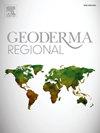Quantifying CO2 emissions from Quebec's agricultural peatland and identifying key parameters for guiding soil conservation strategies
IF 3.3
2区 农林科学
Q2 SOIL SCIENCE
引用次数: 0
Abstract
In Quebec, Canada, field vegetable production largely occurs on cultivated organic soils of Montérégie. These soils become arable following extensive drainage of peatlands, which are highly fertile but vulnerable to subsidence, erosion, and organic matter mineralization. The latter causes carbon losses to the atmosphere through CO₂ emissions and can also lead to dissolved organic carbon leaching. This study quantified CO₂ emissions and identified governing edaphic and meteorological parameters to support the development of carbon compensation strategies for peatland managers. Easily measurable soil parameters were selected to provide farmers with potential proxies for routine soil analysis.
Five commercial sites were selected based on their organic matter (OM) content: F1 (52.2 %), F2 (56.7 %), F3 (74.0 %), F4 (77.4 %), and F5 (91.3 %). All sites, except F3, were devoid of vegetation. Soil CO₂ emissions were measured using manual static chambers over one year (September 2021–September 2022) at bimonthly intervals. Gross annual carbon losses were 4.94 Mg C-CO₂ ha−1 yr−1 for F1, 5.47 for F2, 15.30 for F3, 7.62 for F4, and 3.20 for F5.
Soil temperature, total microbiological activity (fluorescein diacetate hydrolysis), total nitrogen, and pH significantly and positively influenced CO₂ fluxes, while soil water content showed a negative correlation. Annual carbon losses were highly and exponentially correlated with total microbiological activity, underscoring its relevance as a biological indicator and promising proxy for CO₂ emissions.
This study advances understanding of CO₂ emissions from cultivated organic soils and highlights the importance of targeted strategies to mitigate carbon losses and conserve these valuable peatland resources.
量化魁北克农业泥炭地的二氧化碳排放量,确定指导土壤保持战略的关键参数
在加拿大魁北克省,大田蔬菜生产主要发生在蒙塔姆萨的有机土壤上。这些土壤在泥炭地大量排水后成为可耕地,泥炭地非常肥沃,但容易下沉、侵蚀和有机质矿化。后者通过二氧化碳排放导致碳损失到大气中,也可能导致溶解的有机碳浸出。本研究量化了二氧化碳排放量,并确定了控制的地理和气象参数,以支持泥炭地管理者制定碳补偿战略。选择容易测量的土壤参数,为农民提供常规土壤分析的潜在代理。根据有机质(OM)含量选择5个商业用地:F1(52.2%)、F2(56.7%)、F3(74.0%)、F4(77.4%)和F5(91.3%)。除F3外,所有地点都没有植被。土壤CO₂排放量采用手动静态室,每隔两个月测量一年(2021年9月- 2022年9月)。F1的年碳损失总量为4.94 Mg C-CO₂ha - 1年,F2为5.47 Mg, F3为15.30 Mg, F4为7.62 Mg, F5为3.20 Mg。土壤温度、总微生物活性(双醋酸荧光素水解)、总氮和pH显著正影响co2通量,土壤含水量呈负相关。年碳损失与总微生物活性呈高度指数相关,强调了其作为CO₂排放的生物学指标和有希望的代理的相关性。这项研究促进了对栽培有机土壤CO 2排放的理解,并强调了有针对性的策略来减轻碳损失和保护这些宝贵的泥炭地资源的重要性。
本文章由计算机程序翻译,如有差异,请以英文原文为准。
求助全文
约1分钟内获得全文
求助全文
来源期刊

Geoderma Regional
Agricultural and Biological Sciences-Soil Science
CiteScore
6.10
自引率
7.30%
发文量
122
审稿时长
76 days
期刊介绍:
Global issues require studies and solutions on national and regional levels. Geoderma Regional focuses on studies that increase understanding and advance our scientific knowledge of soils in all regions of the world. The journal embraces every aspect of soil science and welcomes reviews of regional progress.
 求助内容:
求助内容: 应助结果提醒方式:
应助结果提醒方式:


